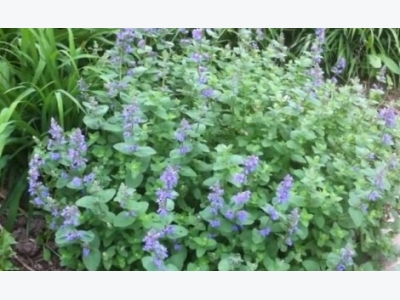How to Grow Catmint

Catmint (Nepata) is a glorious plant for the mixed bed or perennial garden. It tolerates heat, drought and poor soil and spreads quickly. In fact, you'll probably be giving it away to friends before too long.
Hardy in U.S. Department of Agriculture plant hardiness zones 3 through 7, catmint is related to catnip, but it's more extravagant. Mature plants take on a rounded, bushy form with hundreds of tall, graceful stems. The stems have small, pinnate, gray-green leaves that resemble mint leaves. The plants produce a flush of blooms in early summer and will bloom again if you cut them back. Bluish-purple is the most common shade, but some varieties come in pink, white or even yellow.
Like catnip, catmint will attract the neighborhood cats. Compounds in the plant act as a mild hallucinogen or sedative for kitties. Even if you don't own a cat, you might notice flattened areas in the plant where cats have rolled around. To discourage this cavorting, spread a sheet of bird netting over the plants. Not only does catmint attract cats, it attracts bees, moths and butterflies. When in full-bloom, the plants are buzzing with bumblebee and honeybee activity. For this reason, catmint shouldn't be planted near entryways or play areas.
Catmint grows from 12 inches tall to 36 inches tall, depending on the variety. In one season, it can spread up to 3 feet so give it plenty of space and divide it every three to four years. It generally dies back to the ground over the winter.
Planting Catmint
Plant catmint from nursery transplants, from a friend's divisions, or from seed. Sow the seeds outdoors after the last expected frost or start them indoors four to six weeks before planting time. Some varieties are sterile and hybrids may not grow true to seed, so using divisions or transplants is the most reliable way to grow this plant. Catmint blooms best in full sun, except in places with very hot, dry weather, where it can take some afternoon shade. The soil doesn't need to be particularly rich, but it must drain well. Dig in some compost and a bit of manure before planting.
Space the plants 12 to 24 inches apart, depending on the mature size. Water the plants frequently for the first four weeks after planting. Once established, the plants are drought tolerant, but grow best with weekly watering.
Fertilize catmints in the spring before new growth emerges with ¼ cup 10-10-10 fertilizer spread around the base of the plant. Cut the plants back by at least one-third after the first bloom. You can cut them again mid-summer if they become unruly, but don't cut them after August.
Catmint Problems and Pests
So long as the soil drains well, you're unlikely to encounter any problems with catmint. Root rots are common, though, in soggy soils. Catmint can become invasive in moist, warm conditions. Give it plenty of space and divide it frequently to tame it.
Catmint Varieties
Faassen’s catmint
Faassen’s catmint (Nepeta X faassenii) is the most commonly grown species. This plant ranges in size from 12 inches tall to 24 inches tall. Faassen's catmint is sterile and won't self-sow like other species. Varieties include 'Kit Kat,' which grows 2 feet tall and blooms for a long period; 'White Wonder,' which as the name implies, has white flowers; and 'Six Hills Giant,' which grows up to 4 feet tall and produces 12 inch spikes of purple blooms.
Siberian catmint
Siberian catmint (Nepeta sibirica) is a cold-hardy variety that grows 2 to 3 feet tall. This plant has larger leaves than Faassen's catmint and bluish-purple flowers.
Japanese catmint
Japanese catmint (Nepeta subsessilis) is an ideal choice if you have moist soil. It produces lavender to pink blooms on 2 feet tall stems.
Yellow catmint
Yellow catmint (Nepeta govaniana) is native to the Himalayas and produces yellow blooms in mid-to-late summer. Check garden catalogs and online sources if you can't find it locally.
Julie Christensen learned about gardening on her grandfather's farm and mother's vegetable garden in southern Idaho. Today, she lives and gardens on the high plains of Colorado. When she's not digging in the dirt, Julie writes about food, education, parenting and gardening.
Related news
 How to Grow Flowers: The Ultimate Guide
How to Grow Flowers: The Ultimate Guide Whether large or small, every garden deserves some flowers to add color and cheer. And, with hundreds of varieties to choose from
 Care for Fall Flowering Bulbs
Care for Fall Flowering Bulbs These popular garden fillers are some of the most beautiful as well! Fall flowering bulbs are definitely a favorite for keeping the garden in bloom all season
 Caring for Potted Plants
Caring for Potted Plants The perfect place to start to develop your green thumb is right in the comfort of your own home. A potted patio or houseplant is often an inexpensive and simple